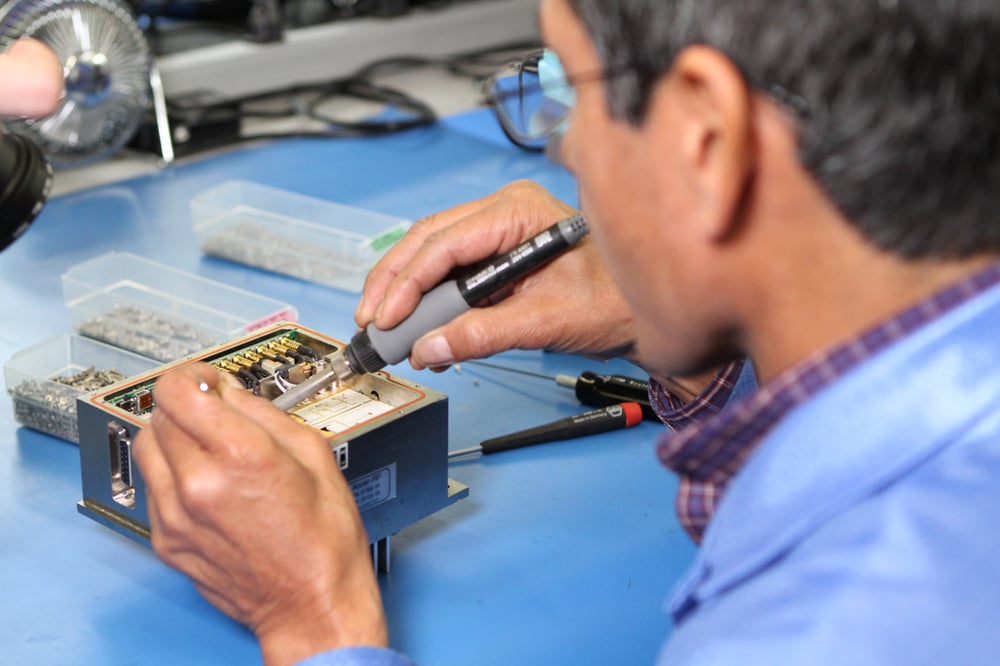4G LTE and previous wireless communications networks relied on an infrastructure consisting of cell barriers defined by a central tower. As users moved from one geographic coverage area to another, the system switched the tower providing service.
This centralized model is about to change. 5G NR relies in part on a portion of the spectrum that contains extremely short wavelengths. These high radio frequencies deliver on speed, but only travel short distances, and physical structures and barriers tend to obstruct them. To make the network function, designers have opted for a system that depends on the deployment of a vast number of smart RF transmitting devices.
Device reliability testing and characterization play a crucial role in ensuring the success and functionality of the 5G network as planned. Accel-RF stands ready with test systems perfectly suited to meet the challenges of deploying mmWave devices and helping companies overcome possible pitfalls in the design and marketing of these devices.
Why 5G Architects Adopted a Decentralized Design
The existing 4G LTE cell service typically utilizes frequencies in the range of 700 MHz to 2600 MHz. Radio waves in this bandwidth travel up to 45 miles and are good at penetrating barriers such as hills, trees, and buildings. It made sense for cell network infrastructure to consist of high-power transmitter towers located miles apart. Each tower covers a specific geographic area, and as users move from one area to another, control software switches the tower they use.
This system has worked adequately for decades, but the new requirements of 5G are forcing its retirement. The two areas where the existing infrastructure falls short are the ones that 5G promises to revolutionize: speed and capacity.
The lightning-fast data transfer rates and near-instant download and streaming rates that make 5G such an attractive proposal require a different delivery method. The mmWave frequencies, in the range of 24 GHz to 100 GHz, hold the key, but not without some pitfalls. Since the extremely short radio waves attenuate so quickly and cannot pass through solid objects, a lattice-like arrangement of multitudes of transmitters will provide the required line-of-sight coverage.
The resulting microcells will consist of low-power mini-transmitters strategically placed on buildings, lampposts, trees and any other available objects, each covering approximately a 10-meter area. Smart chips containing phased-array antennas in each transmitter will intelligently switch frequencies and beam RF signals to users requesting data within each of these microcells.
While 5G wireless represents an elegant solution to providing users with a fast and latency-free wireless experience, it also poses some significant engineering challenges. Manufacturers of the advanced chips that make up the network have to find a balance between devices that degrade gracefully and predictably, and cost-efficiency.
How does 5G use mmWave frequency bands to enhance communication?
How Reliability Testing Solves The 5G Design Puzzle
In addition to relying on a far greater number of individual transmitters to function, the 5G network itself is an interdependent design. If one part fails to do its job, the perceived performance of the whole suffers. To help ensure reliability, designers typically opt to place multiple amplifiers within each transmitter chip. If one amplifier within the phased array fails or starts to degrade, the device switches to another one. This system of self-backups accomplishes excellent dependability, but it significantly complicates chip design and testing.
Within the tightly compacted parameters of an IC package, especially in a device operating in the high RF realm of mmWave, any addition of circuitry can potentially affect performance. Migration of molecules between sandwiched metallic layers, more significant heat generation or unpredictable component interactions at high frequencies can all contribute to failure or degraded operation of an IC device.
Another consideration is, as the 5G network matures, designers will tend to want to add more functions to each device. Packing functionality this way improves options for companies to multipurpose their designs and opens up new markets for uses for 5G that will undoubtedly develop after deployment.
To keep up with the development of 5G, chip manufacturers will rely more on reliability testing and device characterization earlier in the design process. As designers add redundancy, new capabilities and combine multiple devices into single packages, a robust testing program lets them know well in advance of mass production exactly how the changes affect performance.
Device characterization informs decisions on maintenance budgeting by predicting the failure rate of chips once in the field. Without this failure rate data, companies may underestimate the costs of a regular chip replacement program.
Without the predictability provided by full reliability testing and device characterizations, the maintenance of devices within the 5G network ends up being primarily reactive. Once a device fails or ceases to perform as specified, the network performance as a whole has already suffered. The ability to precisely predict when devices will fail or start to degrade gives companies the ability to enact proactive preventative maintenance and upgrade programs to replace parts before network performance takes a hit because of their device.
Ready to explore the testing parameters required by the 5G ecosystem?
Accel-RF Testing Solutions: A Match For 5G Device Needs
To answer these myriad new challenges, Accel-RF offers complete reliability testing and characterization solutions that are both flexible and fully scalable. The test systems thoroughly meet the requirements presented by the roll-out of 5G through their modular design. The core testing functions, such as DC bias and high-temperature exposure, are handled by the basic testbed system. Additional modules provide a variety of customizable RF testing options for 5G devices. This configuration ensures that chipmakers can enact testing programs rapidly and on-budget as new needs for high-frequency devices emerge.
In cases where companies have already invested in proprietary testing systems due to a perceived need for equipment designed to test unique designs, Accel-RF can still help them with the ability to acquire industry-standard characterization data. With an RF module connected to their equipment, Accel-RF’s LifeTest software can generate valuable information on semiconductor failure rates and precise causes.
To stay competitive in this rapidly emerging market, companies must not only demonstrate to product manufacturers that their devices are reliable but also when and how they will eventually fail or start to degrade. Having solid reliability and characterization data in hand is often the edge companies need in order to place their devices in the multitude of products that 5G requires.
Accel-RF has helped provide that competitive advantage to manufacturers of electronic devices for decades with its line of innovative testing solutions. The company has lent its expertise to help set standards for 5G reliability testing, so the industry as a whole considers Accel-RF system reliability data a trusted source.





